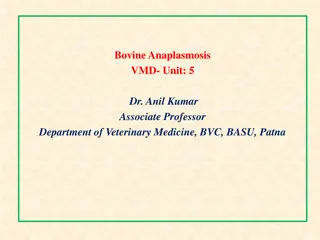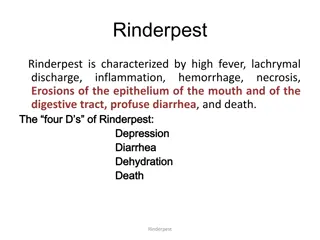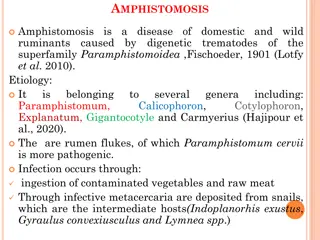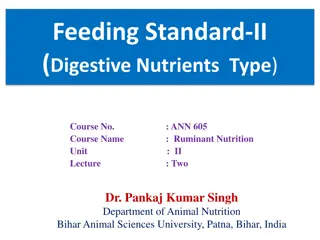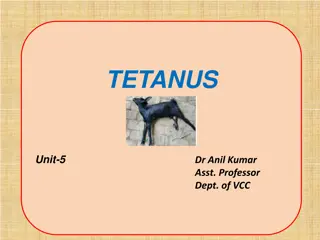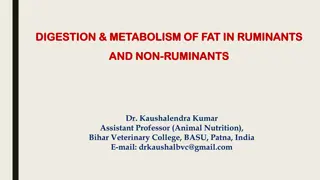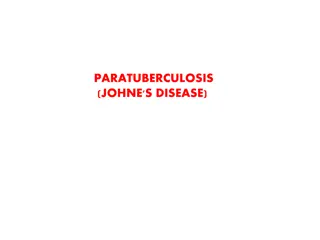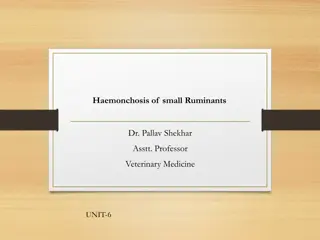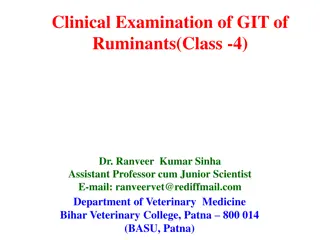Understanding Johne's Disease in Ruminants: Causes, Transmission, and Clinical Findings
Johne's Disease, caused by Mycobacterium paratuberculosis, is a chronic bacterial infection affecting the lower intestinal tract of ruminants. It is characterized by chronic diarrhea and emaciation, mainly seen in mature animals. The mode of transmission includes contaminated food/water, intrauterine infection in calves, and more. Pathogenesis involves mucosal penetration and granuloma formation. Clinical findings include long incubation periods, diarrhea, weight loss, and eventual death. Lesions in affected animals show diffuse thickening of the intestinal wall. Proper understanding of this disease is crucial for effective management and control.
Download Presentation

Please find below an Image/Link to download the presentation.
The content on the website is provided AS IS for your information and personal use only. It may not be sold, licensed, or shared on other websites without obtaining consent from the author. Download presentation by click this link. If you encounter any issues during the download, it is possible that the publisher has removed the file from their server.
E N D
Presentation Transcript
JOHNES DISEASE 7th Semester Anil Kumar Asst. Professor Dept. of VCC
Johnes Disease (Para tuberculosis) Chronic bacterial infection of lower intestinal tract of ruminants characterized by Chronic diarrhea and emaciation. Caused by Mycobacterium paratuberculosis Affects all ruminants. Infection takes years to develop. Disease usually occurs in mature animals ( > 2 Years of age). The primary site of multiplication Terminal part of small intestine and large intestine
MODE OF TRANSMISSION 1.Contaminated food and water with fecal materials. 2.Calves acquire infection in their intrauterine life. 3. Milk 4. Testes and Accessory sex glands. 5. Semen dos not interfere with fertility or conception
Pathogenesis of paratuberculosis (Johnes disease) Ingestion penetration of ileal mucosa Phagocytosed by local macrophages (Payers patches) Inflammatory response (Cell mediated followed by Humoral immunity) Granuloma formation (ileum/colon/mesenteric LNs) Proliferation of sub-epithelial macrophages Thickening of intestine, increased permeability Loss of serum protein/poor absorption Diarrhoea
CLINICAL FINDINGS 1. IP is very long (> 18 months). 2. The most cardinal clinical sign is diarrhea. 3. Diarrhea may continuous or intermittent. 4. Feces is dark with bubbles and no offensive odour 5. No blood or mucous in feces 6. Appetite normal. 7. Hide bound and weight loss. 8.Oedema under loose skin. 9. Recumbence and Death.
DIARRHEA HIDE BOUND
LESIONS 1. Carcasses are extremely emaciated. 2. Characteristic lesions noted in caecum and colon (ileo- caecal valve). 3. A diffuse thickening along with transverse and longitudinal corrugation of the intestinal wall-making irregular folds due to thickening of villi. 4. The surface of the folds are red but not ulcerated. 5. Absence of necrosis, nodule formation and calcification--- In Cattle.
DIAGNOSIS 1.Gross lesions of intestine is highly suggestive. 2. Demonstration of acid-fast bacilli in smears or sections of mucosa. 3. Mucosal scraping from rectum in the living animal and examined under microscope(reveal innumerable acid fast bacilli). 4. Fecal culture (Detecting clinical and symptomatic shedders) 5. Intradermal johnin test. 6. Serological tests: i. CFT ii. LAM-ELISA (Lipoarabinomannan antigen ELISA) iii. AGID iv. FAT(more sensitive and specific) and used identifying preclinical cases and advanced clinical cases.
TREATMENT AND CONTROL 1. Treatment do not give encouraging result due to advance course of disease. However, anti tubercular drug (streptomycin @50 mg/Kg)may be used. In Goat Dihydrostreptomycin 500mg IM and Rifampicin,300 mg is very effective 2. Control measures for infected herd Reduce contamination by good sanitation Do not spread manure on pasture land Raise young stock in uncontaminated environment, separate from mature animals.
3.Reduce incidence in herd test mature animals every 6 months remove test-positive animals immediately cull any apparent clinicals regardless of test results purchase only from tested clean herds vaccinate infected herds Vaccine (Valle s vaccine) consists of live M. paratuberculosis Adjuvant equal parts liquid paraffin and olive oil with finely powdered pumice stone. Dose @ 1.5ml s/c to calves (< 1 month of age). Sigurdsson vaccine Heat killed vaccine



